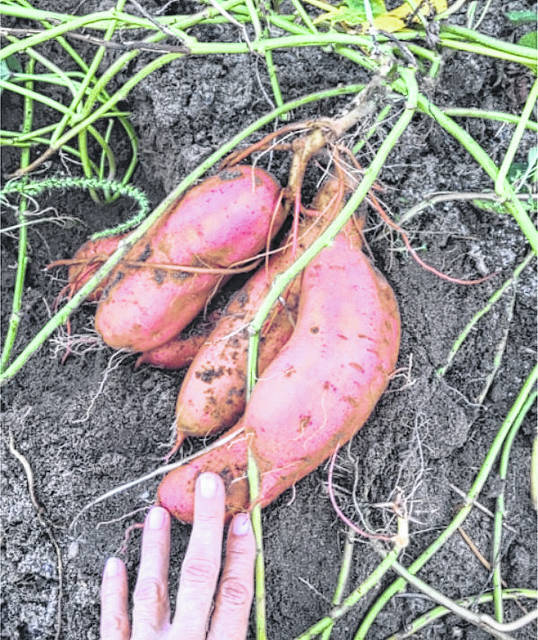Fall brings its own personality, characteristics – even colors. Orange features prominently. We know Fall brings sudden cravings for all things pumpkin spice. While pumpkin may be the shining star in autumn, it is also a time for sweetpotatoes, which are harvested in September and October.
Sweetpotatoes are nutrition powerhouses, considered a “superfood,” that deserves to be on the menu throughout the year, not just covered in brown sugar and marshmallows on the Thanksgiving table. This article is not about sweetpotatoes recipes, however. North Carolina is the number one sweetpotato producing state in the country, growing about 60% of the country’s supply. According to the NC Sweet Potato Commission, in 2016 North Carolina had 95,000 acres of sweetpotatoes, most of which are found in southeastern NC. Do you know how sweetpotatoes are actually grown? Read on!
Conventional knowledge has the sweetpotato originating in Central America, however recent research suggests the plant may have originated in Asia and from there was moved around by indigenous peoples. You may have noticed I’m using “sweetpotato” as one word, which is technically the proper usage (though the two word version is most common). It is not a “sweet” potato – in fact, sweetpotatos are not potatoes at all, but are members of the Morning Glory family.
Sweetpotatoes are also not yams: a yam is a completely different creature, an edible tuber from a plant in the lily family with a very starchy, dry flesh that is not sweet at all. They are frequently used in Caribbean cooking. Sweetpotatoes themselves may look very different: there’s orange flesh, red flesh, white skinned with white flesh; purple skinned with white flesh; and purple skinned with purple flesh. The flavor and texture can vary quite a bit between varieties, so it’s worth experimenting to determine which you like best. Covington, an orange flesh variety, is the most common variety grown in North Carolina.
The sweetpotato is a tropical perennial, grown as an annual for commercial production. Unlike Irish potatoes which use pieces of the potato as “seed” for a new crop, sweetpotatoes are grown from short clippings of vines, called slips, which are cut off the parent planted in a specially prepared slip bed. The slips, which typically have no roots and just a few leaves, are stuck in prepared soil in early June. From planting until harvest in late September or early October, plants must be watered, fertilized, and protected from pests, including weeds, wireworms and deer, which enjoy eating the vines and even dig roots for eating.
Once roots get to the desired size, between 85 and 120 days, it’s time to harvest. With a special plow, sweetpotatoes are flipped to the top of the soil, and each sweetpotato is hand harvested, to protect the delicate skin which is easily damaged with rough handling or mechanical harvesting (which is used for sweetpotatoes destined for processing). After harvest, sweetpotatoes must be cured by storing them at around 85 degrees with relatively high humidity for a week or two. The curing process allows the skin to toughen up, heals injuries caused by harvest, and turns the starches in the root to sugar, creating the sweetness they are known for. Sweetpotatoes can be stored for up to a year in proper conditions (ideally, around 60 degrees) without significant loss of quality.
Consider using sweetpotatoes in dishes throughout the year. They’re delicious, nutritious, and a great way to show pride in North Carolina! To learn more about growing sweetpotatoes, call the Extension office at 910-997-8255, visit our website or follow us on Facebook.
Paige Burns Clark is the director of the Richmond County Cooperative Extension and the horticulture agent.

